When generating a PDF it totally ignores my font-family attribute applied to my CSS. Instead of say Verdana, it uses Times New Roman. So my CSS look like:
.sub-header {
font-size: 1.4rem;
text-transform: uppercase;
font-family: NeutraText-Book !important;
padding-bottom: 1.5rem;
}
The PDF is generated like this:
$pdf = PDF::loadHTML($view);
return $pdf->stream();
How can I set a font I want?
You need to have the font loaded in DomPDF. Check this page for details.
Dompdf's About Fonts and Character Encoding says the font utility is included but doesn't tell you how to get it and run it. Here's how:
Download load_font.php to the root directory of your project.
curl -o load_font.php https://raw.githubusercontent.com/dompdf/utils/master/load_font.phpOpen load_font.php with a text editor (e.g. vim). Change
require_once "autoload.inc.php";torequire_once "vendor/autoload.php";Run the utility with the name of the font you are registering and the path to the TFF file. For example:
php load_font.php 'Brush Script MT' https/fonts/brush-script-mt.ttfRead the code for load_font.php for more information about how to use this command.
Thanks for the answer by Brians above, but in my case only one option worked which is by installing font using "dompdf/www/fonts.php"
it installed the font by Browsing to dompdf/www/fonts.php in the included admin site. (it will be something like http://yoursite.com/sites/all/modules/print/lib/dompdf/www/fonts.php)
Go to bottom of the page, and click on a link
it comes up with alert saying "password must be changed in dompdf_config.custom.inc.php".
Now, again click on
[Authenticate to access this section][2], it asks for user name and password. enter user user name and password which u have given in step one.if you browse the same fonts.php path again in your browser you can find install new fonts section in the bottom of the page( you can see in image) ,(however, i moved my rockwell.ttf and rockwell.afm files to fonts folder first and then i installed here)
,(however, i moved my rockwell.ttf and rockwell.afm files to fonts folder first and then i installed here)
choose your desired font ttf file and then install it. it installed and showing in installed fonts but it did not work for me. so I had to create to .afm file for my new font.(here i wanted to use rockwell font)
steps I did to create my rockwell.afm file. 1
I did this like dompdf other 14 native fonts, I'm not sure how acceptable is this. but it worked for me. I just wanted to get it done.
I've added my rockwell font where ever i found the dompdf native font names in php files
Added "rockwell" to
public static $native_fontsarray in dompdf/include/dompdf.cls.php filedompdf/lib/fonts/dompdf_font_family_cache.dist.php file like below
thats it. it generated rockwell.afm file for me like this
just use whatever font family you want to use like
PDF documents internally support the following fonts: Helvetica, Times-Roman, Courier, Zapf-Dingbats, & Symbol (all using Windows ANSI encoding). dompdf will embed any referenced font in the PDF so long as it has been pre-loaded or is accessible to dompdf and referenced in a CSS
@font-facerule. The loading process is necessary in order to produce the font metrics used for type setting.dompdf supports the same fonts as the underlying R&OS PDF class: Type 1 (.pfb) and TrueType (.ttf) so long as the font metrics (.afm/.ufm) are available. The bundled, PHP-based php-font-lib provides support for loading and sub-setting fonts.
The process for loading a font varies depending on your needs and server access. There are three ways you can load a font:
Use CSS @font-face rules to load a font at run-time
No command line access required. So long as the font you want to load is available online you can load it easily via CSS.
From the command line use dompdf/load_font.php
If you have access to the command line then loading a font is as simple as:
Run the command without any parameters to see help text. Quickly, though, the parameters are: name of the font, normal font file, bold font file, italic font file, bold-italic font file
Browse to dompdf/www/fonts.php in the included admin site
Self-explanatory (sample). The only thing you need to do is make sure you've modified the admin username/password combo
Note: load_font.php and the admin site will not be included by default starting with dompdf 0.7.0
Adapted from the dompdf wiki (Unicode How-To, About Fonts and Character Encoding) and other sources.
I have a similar problem and i have been looking a solution for 2 days...With the new version, the accepted answer does not work any more.
@jay-bienvenu answer is correct. The new version of DomPDF does not include everything and also there is a very poor documentation.
So you will have to:
download load_font.php and place it to the root directory of your project:
curl -o load_font.php https://raw.githubusercontent.com/dompdf/utils/master/load_font.phpthen open load_font.php with your editor and place the correct path to your autoload.inc.php, eg
require_once 'lib/dompdf/autoload.inc.php';Open the command line, go to the root folder of your project, and run the utility with the name of the font you are registering and the path to the TFF file eg
php load_font.php SourceSansPro ./pathToYourFolder/lib/dompdf/SourceSansPro-Regular.ttf ./pathToYourFolder/lib/dompdf/SourceSansPro-Bold.ttfNow the font is installed. You may use it as you would normally would as a webfont in html:
and to make the pdf in php:
EDIT: i made a blog post about how to use dompdf and apply custom fonts so that things can be more detailed: https://www.blog.lab21.gr/using-domdpf-create-pdf-php